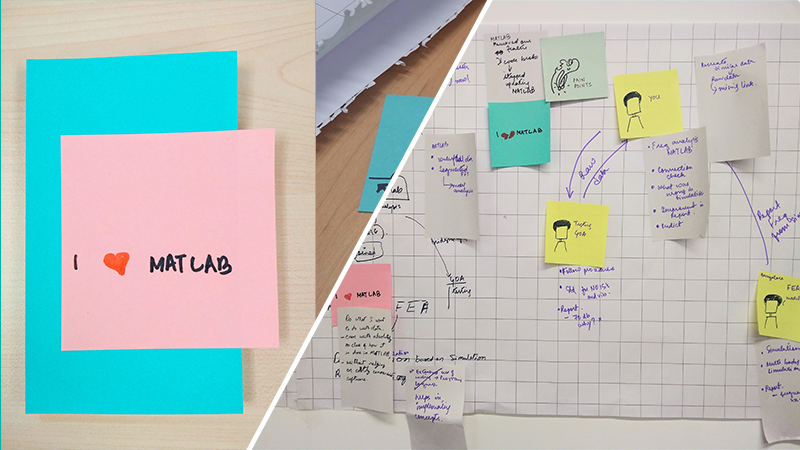EXPRESSION Post-its – playful experiment @MathWorks

BACKGROUND
This project was carried out as a part of my employment with MathWorks India at MathWorks Design Team under the guidance of my co-workers Jyotirmaya Mohapatra and Praneet Kopula, . I was a User Experience Specialist for MathWorks, India . Collecting information on new users’ experiences with MATLAB and Simulink was one of the first assignments I was given.
My task for this assignment would include,
- Conducting interviews with each participant to learn about their experience using MATLAB and/or Simulink.
- How and why they employed these tools,
- Difficulties they might have met on this journey,
- Any workarounds they may have found along the way
- Some things they adore, and others that could use improvement.

I prepared for the interview as I had been instructed to do during my Masters program — I wrote a questionnaire to ask our participants and a script to choreograph the session. I became aware of a gulf between myself and my volunteers throughout my pilot tests. We were unable to establish the level of comfort required for information sharing. This might have been due to the senior participants or the fact that I was a relative newcomer to the organization.
What if I gave them the freedom to describe their own journeys rather than asking them questions?
I can serve as their facilitator and so it began…
METHODOLOGY

- Paper and pen: Each participant would receive a lengthy piece of paper to depict their journey. At the left and right ends of the paper, there would be two marks.

-
Expression Post-its:
We wanted to collect all the emotions, achievements, pain points, milestones and landmarks each user achieved during their journey with MATLAB and Simulink. In order to do so we used, Post-its with illustrated expressions of emotions. This also served as a spur to find out more about their work.
-
Follow up questions: A simple “why” or “how” question as a follow-up during this study enabled participants to offer a lot more data.
EXPECTATIONS
The expectation after this study was to collect as many data points as possible, and at the same time develop a relationship with the participants through their journey.

EXPRESSION Post-its
- Expression post-its - what were those? My co-worker and mentor Jyotirmaya Mohapatra at MathWorks, introduced me to Jake Knapp’s book Design Sprint. The book describes how to lead a design sprint that lasts for five days. The sprint’s goal would be to comprehend the product through its goals, difficulties, and usefulness.

I was curious to see if we might elicit similar reactions by naming the feelings our participants had to be experiencing. Expression Post-its were a result of this. The primary goal of these expression post-its was to determine whether they could evoke any feelings and the associated event.


- Expression post-its - how to use them?
We asked the participants to use these post-its when ever they felt the emotions illustrated and below is one of the examples of such maps -

Conclusion
The technique was successful in extracting important data regarding participant use of MATLAB and Simulink. It was carried out inside of MathWorks with a total of 5 participants. Due to confidentiality restrictions, we are unable to disclose the interview’s findings.
FIN.